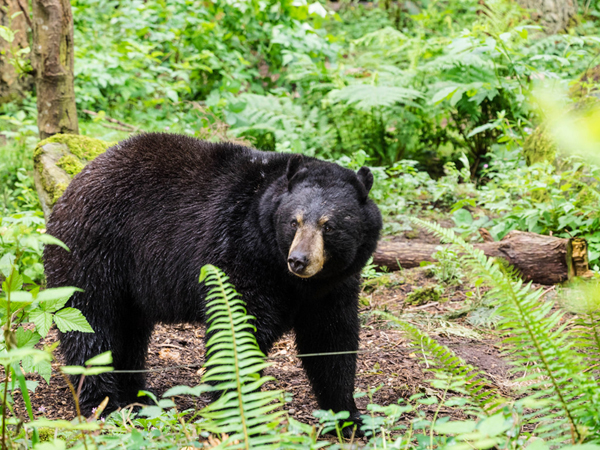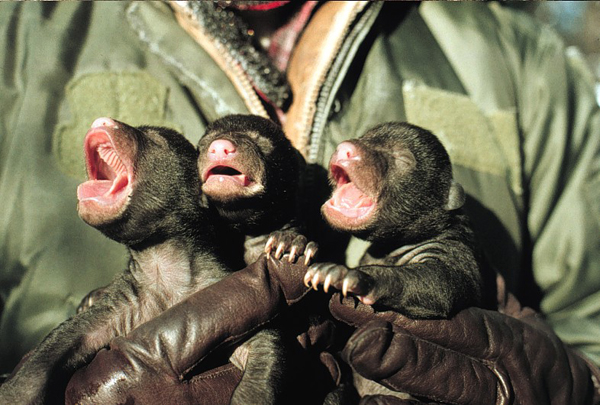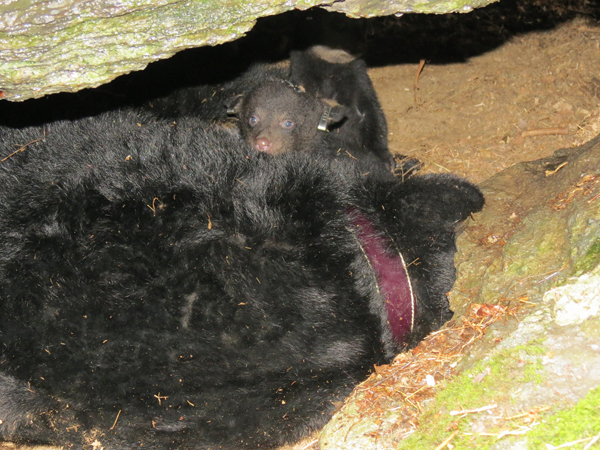(Ursus americanus)
Description & Range:
Black bears are stocky animals with short, thick legs and glossy black or brownish coats. Occasionally, black bears can also be cinnamon or blond in color and can contain patches of white. Black bears are the smallest North American bears, ranging from 5-6 feet long from muzzle to tail. A black bear’s tail is short- averaging 3-5 inches in length. Males and females are generally similar in appearance, but males often are a little larger. In general, sows (females) weigh from 110-250 pounds while boars (males) can weigh from 150 to 450 pounds.
Historically, black bears were found throughout much of North America. However, their habitat is now limited to forested areas in 40 states and Canada. In Maryland, Black bears are located primarily in Garrett, Allegany, Washington, and Fredrick counties. Populations are highest in Garrett and Allegany counties, with bear numbers rising in the remaining areas. In the spring, black bears are often sighted in other areas of the state.

Black bear by Amit Patel, Flickr CC by 2.0
Habitat:
Black bears are forest dwellers and can usually be found in mixed deciduous and conifer forests. Black bears prefer areas with thick understories that contain abundant food resources such as acorns, nuts, berries, and seeds.
Diet:
Bears are opportunistic feeders, which mean they will eat whatever is accessible. Largely vegetarian, common foods include berries, cherries, other fruits, acorns, beechnuts, hickory nuts, insects, roots, grasses, reptiles, amphibians, and carrion. Acorns remain the single most important natural food for bears in Maryland. As the opportunity arises, bears will also eat garbage, agricultural crops, and bird food. Bears feed heavily during the fall months in order to increase fat reserves for the upcoming winter.
Reproduction:
Black bears typically breed at 3 years of age. During June and July, boars will travel long distances to mate with a sow. Generally, the fertilized egg will not implant until November (aka delayed implantation). If the female does not gain enough weight before hibernation, then her body may reabsorb the eggs.
Cubs are born in January with closed eyes and fine, down-like fur. The cubs typically weigh between ½ and 1 lb. Sows give birth to 1-4 cubs which remain with the sow for 18 months. After a year and a half, the family unit will break up and the yearling cubs will find their own territory to inhabit.

Newborn cubs during a den survey by USFWS.
Sounds:
Black bears communicate with sounds, body language, and scent marking. Typical black bear sounds include grunts and tongue clicks when relaxed. Cubs also make a humming sound similar to a purr when nursing. When unsettled, black bears will blow and clack their teeth as a warning sign. When threatened, a black bear may also make a bluff charge.
Behavior:
Black bears are active throughout the day and sometimes at night. Right before denning, black bears can actively forage for up to 20 hours per day! Generally, black bears are solitary and spend their days foraging for food.
Prior to denning, black bears will consume up to 20,000 calories per day and will increase their mass by 30-35%. Black bears are not true hibernators, but they do slow down their heart rate and breathing while denning. Typically, Maryland black bears den in late November through December, pending on the weather. Black bears will den under large boulders, within simple depressions, in tree cavities, or even under porches and other human dwellings.

Each year, Wildlife and Heritage Service biologists visit dens of radio-collared sows to collect reproduction data. Here is a sow and tagged cubs in a den in Frederick, MD.
Management:
The Maryland Wildlife and Heritage Service is tasked with managing black bears in Maryland. Staff carefully work to balance the needs of both the species and a diverse public. Black bear population management is necessary to reduce human-bear conflicts and damage caused by black bears. The Maryland Black Bear Management Plan has six main management goals:
- Ensure that healthy black bear populations are maintained statewide.
- Conserve and manage habitat for black bears.
- Promote human safety, protect agricultural income, protect personal property, and address conflicts between humans and bears.
- Ensure that public values are considered in the various bear management scenarios.
- Ensure that all aspects of Maryland’s black bear management program are conducted in a professional and humane manner.
- Provide funding mechanisms to support black bear management in Maryland.
For More Information: